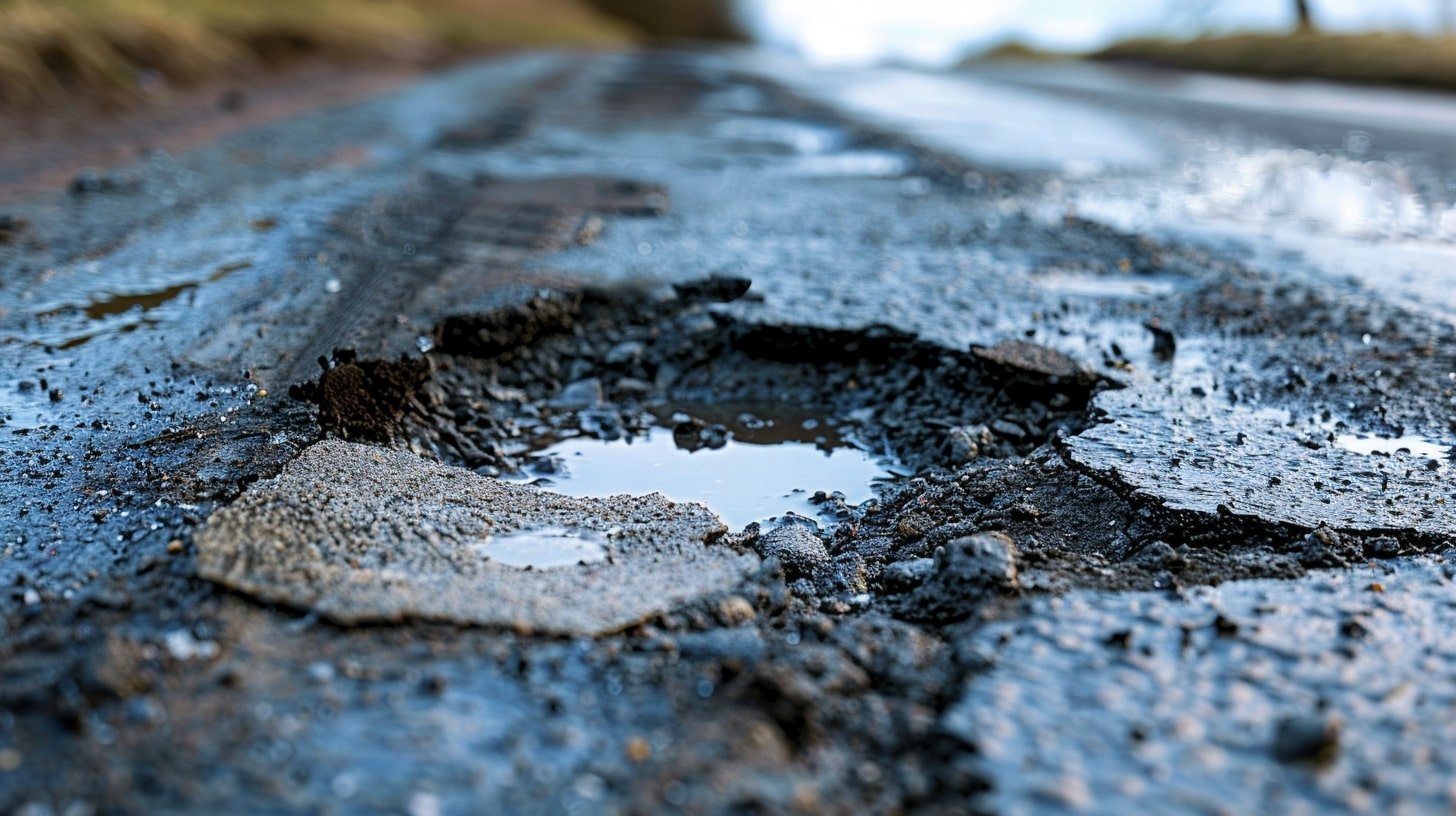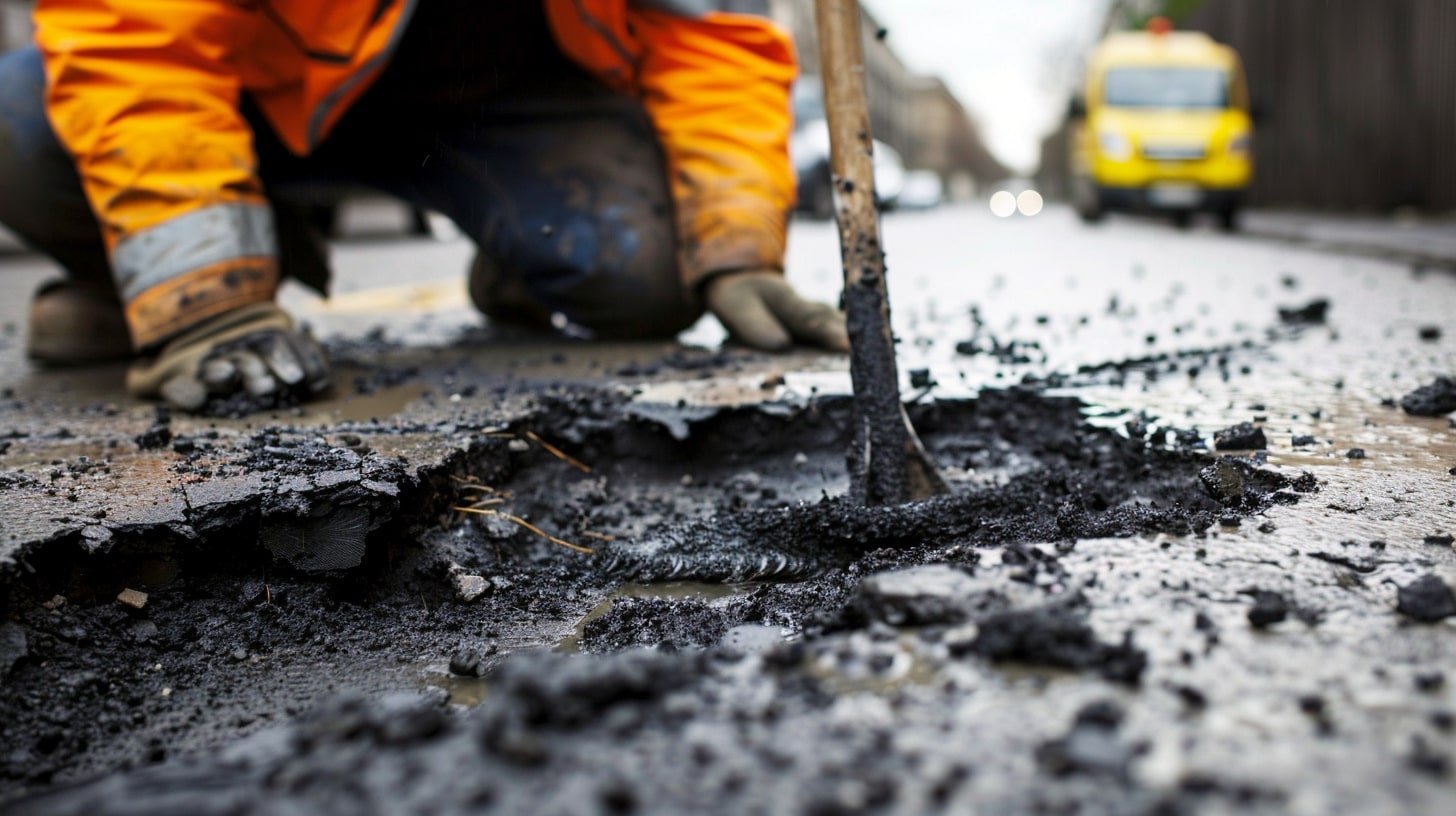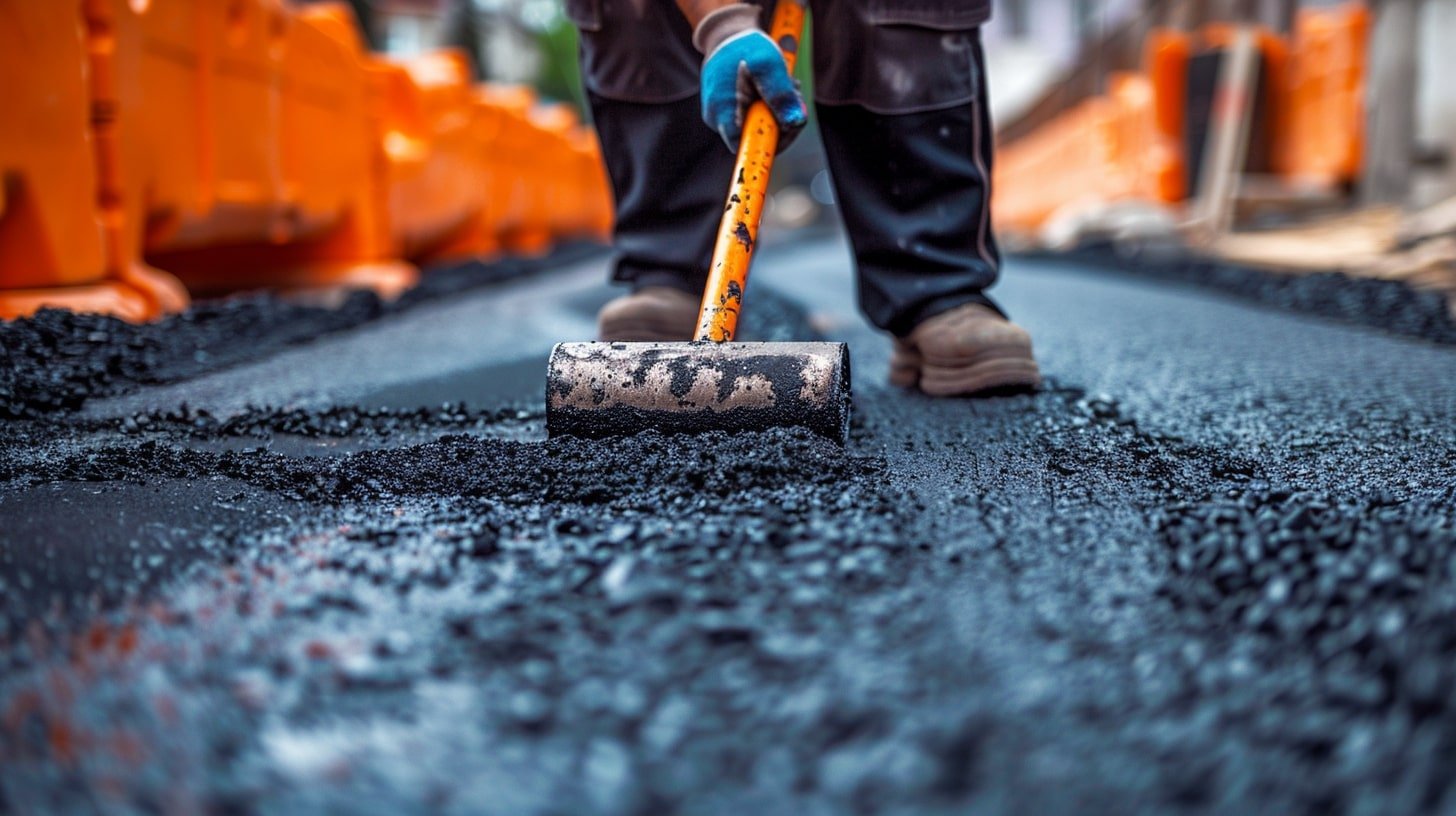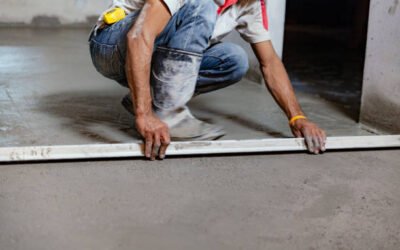Welcome to your definitive guide on utilizing hot mix asphalt for pothole repairs—a common nuisance that plagues many roads and parking lots, and a critical component of road maintenance. Hot mix asphalt is renowned for its strength, resilience, and ability to adhere to the strict demands of varying climates, especially those in Canada where weather conditions can be extreme. This guide provides detailed insights into the properties of hot mix asphalt and practical advice on how to use it efficiently for long-lasting pothole repairs. Whether you’re a homeowner looking to tackle driveway repairs or a professional road maintenance worker, you’ll find the necessary information to understand the benefits and processes involved with hot mix asphalt. Let’s dive into the world of road repair and explore how hot mix asphalt can be your go-to solution for combating the cratered menaces that disrupt the smooth sailing of vehicles.
Table of Contents
What is Hot Mix Asphalt?
Hot Mix Asphalt (HMA) is a combination of approximately 95% stone, sand, or gravel bound together by asphalt cement, a product of crude oil. Asphalt cement is heated and mixed with the aggregate at a mixing facility to produce HMA, which is then transported to the job site for laying and compaction to construct roads, pathways, and parking lots.
The “hot” in Hot Mix Asphalt refers to the fact that the mixture is heated to a high temperature (around 300°F to 350°F) to ensure that the asphalt cement is fully liquid. This allows the mixture to be fully coated around the aggregate particles, ensuring proper adhesion and compaction. Once laid and compacted, the mixture cools and hardens, forming a durable pavement surface.
HMA is favoured for its durability, resilience, and ability to be formed and compacted as needed for various uses. It is also valued for its ability to be recycled; reclaimed asphalt pavement (RAP) can be reused in new HMA, making it an environmentally friendly option for paving. The formulation of HMA can be adjusted for specific performance characteristics by altering the proportions and types of aggregate, the type and amount of asphalt cement, and the inclusion of additives or
Understanding Hot Mix Asphalt Components
Aggregate Materials in Hot Mix Asphalt
The robust foundation of hot mix asphalt lies in the thoughtful selection and combination of aggregates—these include crushed stone, gravel, and sand. The quality of these materials is paramount to the performance of the finished asphalt, with a range of sizes from fine particles to larger stones creating a tightly packed, sturdy surface. In Canada, aggregate quality must meet strict standards to ensure the asphalt can withstand freezing and thawing cycles without cracking or heaving. Transport Canada provides specifications that guarantee the most durable combination of materials for the local climate.
The Role of Bitumen in Binding
Bitumen, a sticky, viscous liquid also known as asphalt cement, is the key binding agent in hot mix asphalt. Its role is to adhere the aggregates together to form a cohesive mass that can bear the loads of traffic. The quality of bitumen is essential for the flexibility and waterproof characteristics of the pavement. Canadian bitumen is often derived from Alberta’s oil sands and is widely revered for its natural properties that contribute to the asphalt’s resistance against harsh winters.
Importance of Proper Temperature
Temperature is a crucial factor in the application of hot mix asphalt. It must be heated to approximately 150°C to ensure proper viscosity for application and compaction. This is particularly important in colder Canadian climates, where low temperatures can cause the material to cool too quickly, leading to an improper set and potential weaknesses in the pavement. Consistent temperature control from the plant to the site is mandatory to maintain the workability of the hot mix asphalt.
Did You Know? Canada’s vast geography requires customized hot mix asphalt solutions; in fact, mixtures in the northern parts of the country are specially formulated to remain flexible even at lower temperatures, accommodating the unique Arctic conditions.
Understanding the composition and characteristics of hot mix asphalt is not only a matter of technical diligence but a foundation for anyone looking to apply it effectively for repairs. Armed with knowledge on aggregates, bitumen, and the crucial role of temperature, you are now equipped to understand how these components work in harmony to provide a long-lasting repair solution.
Benefits of Using Hot Mix Asphalt for Repairs
Longevity and Durability
One of the principal advantages of hot mix asphalt is its exceptional durability. The tightly-knit structure created by the high-quality aggregates and bitumen offers a resilient surface capable of withstanding high traffic volumes and the deleterious effects of time. When properly installed, a hot mix asphalt repair can last upwards of 15 to 20 years, even under the stress of Canada’s severe weather conditions.
Weather Resistance
Hot mix asphalt’s design includes consideration for the climates it will serve. It exhibits excellent weather resistance, enduring extreme heat, cold, and precipitation. The hot mix is capable of contracting and expanding without significant cracking, which is crucial for withstanding Canada’s freeze-thaw cycles. This flexibility reduces the likelihood of potholes re-forming in the same location, ensuring road users a smoother ride for longer periods.
Cost-Effectiveness
While the initial investment might seem significant, the long-term cost-saving benefits of hot mix asphalt are undeniable. Its longevity means fewer repairs and maintenance interventions compared to other repair methods. Additionally, the materials used in hot mix asphalt are abundant and sourced locally, a factor that drives down costs significantly. The efficiency in the application process also means that traffic can resume quickly, minimizing economic disruptions due to extended road closures.
Key Takeaway: Investing in hot mix asphalt repairs may offer cost savings over time, providing exceptional value for both the short and long term—vital for municipalities managing tight budgets and for homeowners looking to mitigate frequent repair costs.
With unmatched longevity, formidable weather resistance, and cost advantages, hot mix asphalt is a compelling choice for anyone seeking a reliable pothole repair solution. These benefits demonstrate why it has become a staple in road repair strategies across Canada and worldwide.
Preparing for Pothole Repairs with Hot Mix Asphalt
Before diving into pothole repairs, several preparatory steps are essential to ensure that the hot mix asphalt adheres properly and stands the test of time. Here’s how to set the stage for a successful repair.
Assessing the Pothole Size and Depth
Initial assessment of pothole dimensions is critical—it influences the amount of hot mix asphalt needed and determines the repair method. Small and shallow potholes require a straightforward fill-in, while larger, deeper potholes may need a more extensive approach, including the removal of compromised material around the pothole’s perimeter.
Necessary Tools and Equipment
Having the right tools is paramount. For basic repairs, you’ll need a tamper for compaction, a shovel or an asphalt lute to spread the hot mix, and personal protective equipment. For larger repairs, additional tools such as an asphalt cutter for clean edge creation, a plate compactor, and a tar kettle or hot box to keep the asphalt at the required temperature are necessary.
Safety Measures Before Starting
Safety cannot be overstated when dealing with hot materials and potential traffic hazards. Canadian standards dictate the use of appropriate high-visibility clothing, sturdy gloves, and eye protection. Additionally, set up traffic cones and signage to alert oncoming vehicles of the work zone.
Fun Fact: The world’s largest known pothole repair was accomplished using hot mix asphalt, covering an area equal to four hockey rinks—a true testament to the material’s versatility and effectiveness, even in large-scale applications.
Once you’ve assessed the pothole, gathered your tools, and established a safe work environment, you’re ready to move on to the actual pothole repair process, paving the path to a smooth and reliable surface.
Step-by-Step Guide to Pothole Repair
Cleaning the Pothole
Properly cleaning the pothole is the first critical step in the repair process. Remove all debris, water, and loose stones to ensure a solid foundation for the hot mix asphalt. A clean, dry surface allows better adhesion of the new material, reducing the risk of future disintegration.
Applying the Hot Mix Asphalt
Once the pothole is prepared, apply the hot mix asphalt in layers, using a shovel or asphalt lute to distribute it evenly. Each layer should be compacted before adding the next to remove air pockets and ensure density. The layering method helps in building a durable patch that can withstand traffic and weather changes.
Compaction of the Asphalt
Compaction is perhaps the most vital step in the repair process—the better the compaction, the more durable the repair will be. A plate compactor is ideal for ensuring the hot mix asphalt is uniformly compressed. The edges of the patch should blend seamlessly with the existing pavement to prevent water infiltration. With these steps diligently followed, the repaired pothole should now be level with the surrounding surface and ready to take on the rigours of daily traffic. Remember to allow adequate curing time before opening the repaired area to vehicles.
Best Practices for Applying Hot Mix Asphalt
Temperature and Weather Conditions
Applying hot mix asphalt during optimal weather conditions is crucial. Dry, warm weather, typically above 5 degrees Celsius, is ideal for pothole repairs as it allows the hot mix to cure properly. Be mindful of the temperature of the asphalt itself—it needs to be kept hot to be workable and effective.
Ensuring Proper Compaction
Uniform and ample compaction ensures that the hot mix asphalt adheres well and sets as intended. Do not rush this step, and consider multiple passes with the compactor to achieve a tightly packed, stable repair.
Avoiding Common Pitfalls in Application
Common mistakes in asphalt repair include under-heating the mix, inadequate cleaning of the pothole, and poor compaction. Avoid these pitfalls by adhering strictly to application guidelines and best practices shared by local Canadian road construction experts.
Key Takeaway: Best practices in the application process are not just guidelines but the roadmap to a seamless, long-lasting pothole repair with hot mix asphalt—neglecting them is often the difference between a job done right and a patch that fails prematurely.
DIY vs. Professional Pothole Repair
When to Consider DIY Repair Methods
DIY might be suitable for small, straightforward repairs in areas that don’t bear heavy traffic. With a basic understanding of the process and the necessary tools, homeowners can typically manage these fixes economically and effectively.
The Pros and Cons of Professional Services
Professional services bring expertise, high-grade equipment, and an understanding of local road conditions to the table. While this option may incur higher upfront costs, the quality and reliability of the repair often justify the expense, especially for larger or more complex pothole issues.
How to Choose the Right Option for You
Consider factors like the size and location of the pothole, your skill level, the availability of tools, and your budget. For major repairs, especially those on public roads, professional services may be required by Canadian municipalities to meet safety and quality standards. Whether to undertake pothole repairs as a DIY project or to enlist professional help often comes down to balancing practicality with the quality and longevity of the repair—with proper understanding, each option has its place in maintaining smooth and safe pavements.
Conclusion: Ensuring Smooth Journeys with Hot Mix Asphalt Repairs
In conclusion, hot mix asphalt stands out as a robust solution for addressing the ever-present problem of potholes, providing a blend of durability, weather resistance, and cost-effectiveness. Through this guide, we’ve explored the different components that make up hot mix asphalt, the benefits of using it for repairs, preparation tips, and the essential steps and best practices for application. Moreover, we’ve offered insights into the choice between DIY efforts and professional repair services. Effective pothole repair is not just a matter of filling in a gap; it requires careful consideration, proper planning, and precision in execution. By following the guidelines outlined in this article, you’ll be on the right track to creating seamless, long-lasting pothole repairs that can stand up to the harsh conditions faced on Canadian roads. Armed with this knowledge and understanding of hot mix asphalt application techniques, we encourage you to tackle pothole repairs confidently—whether you choose to do it yourself or seek professional assistance. Either way, the goal remains the same: maintaining safe and comfortable roads for all users and extending the lifespan of our valuable infrastructure. Always remember, well-maintained roads lead to smoother journeys and healthier communities. Happy paving!
FAQs
Can hot mix asphalt be used in any weather condition?
While hot mix asphalt is versatile, it is best applied in dry, warm conditions, ideally above 5 degrees Celsius. In colder or wet weather, the mix can cool too quickly, leading to poor compaction and an ineffective repair. Always check local weather forecasts and consult road repair guidelines to ensure proper application.
How long does hot mix asphalt take to dry?
Hot mix asphalt typically takes about 24 hours to cool down and cure sufficiently to bear traffic. However, this can vary based on temperature, humidity, and the thickness of the applied layer. It’s essential to allow adequate time for the asphalt to set before reopening the repaired area to vehicles.
What are the safety precautions when working with hot mix asphalt?
Safety measures include wearing high-visibility clothing, heat-resistant gloves, eye protection, and a mask to avoid inhaling fumes. Additionally, traffic control measures such as cones and barriers should be in place to protect workers and drivers alike.
Can potholes be permanently fixed with hot mix asphalt?
Although no repair can be considered truly permanent due to eventual wear and tear, hot mix asphalt offers one of the most durable solutions for pothole repairs. With proper preparation, application, and maintenance, hot mix asphalt repairs can last for many years, even in climates with severe weather fluctuations like those in Canada.
How can I ensure the best finish when compacting the asphalt?
To ensure a smooth finish, apply even and continuous pressure when compacting the hot mix asphalt. Multiple passes with a plate compactor may be necessary, and the edges of the patch should be thoroughly compacted to blend seamlessly with the existing pavement to prevent future water infiltration. Good compaction will result in a more stable and longer-lasting surface.









